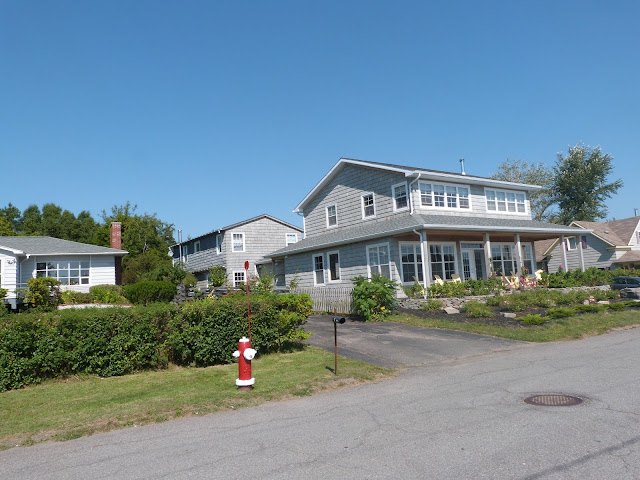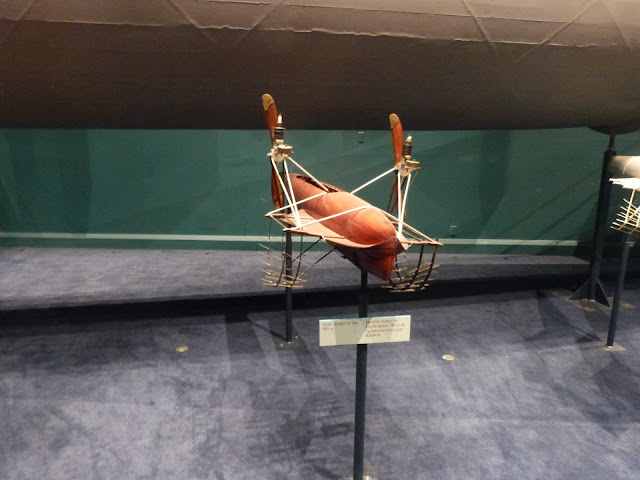Having waited at the lockgates (and visited St Peters and the Distillery at Glenville) we enter the lakes - very large body of water, pretty much landlocked, there is a narrow entrance at the top and the lockgates at the bottom (St Peters). Scenery (and weather) lovely. A very special place. Sailing here is great, flat seas, bright sunshine and normally 5-10 knots of wind. (we usually had less...)
On the way through the lakes there were a few houses, and also an first nation reservation.
St Peters to Iona was a pleasant 20 miles, there is a bridge here that needs opened, this happened promptly when I radioed the bridgekeeper. On the "other side" there is a government wharf. We came across a lot of these, built for fishermen and recreation I tend to keep clear if they are packed with fishing boats (fishing boats sometimes play dodgems). I need not have worried...
The roller reefing had jammed so we dropped the sail - I later discovered if the halyard is too tight the foil lifts up and jams the top swivel - I will go up the mast before crossing the Atlantic to check this. For now I keep the halyard loose.
Although fender boards were called for there was also large tires helping keeping us off. A couple of rod fishermen helped us dock. There was a wild current approaching the pier, but we crept up to avoid it here.
Lonesome ownsome.
There is a lovely church here but the main draw is a Scottish Gaelic museum. A stiff 30 minute walk away.
Saw some nice houses on the way
They go in for big lawns here - maybe they like ride-on mowers, maybe to get a breeze and keep the insects at bay?
And then into the museum - think Ulster Folk and transport, without much transport...
There is an authentic ole fellaw with a hat! This house and the next is a bit before and after - the above is a copy of an actual Scottish house (bothy?)
A lovely touch is that the place is full of character actors - she told a lovely story and answered questions as if she was about to leave her native home, Out in the outer Hebrides. (Barra)
They could only travel with what they could carry, Men brought there tools, often without shafts to save space. The women dressed up in 4 sets of clothes to bring more with them. - sounds like how to defeat the high hold baggage charges of air travel today?
First generation arrivals got a log cabin build quickly
Needs a lot of axe work, but fairly warm I would think.
Complete with stone fireplaces and civilised living (relatively). The (new) islanders prospered quickly and the next type of house and contents were even better
And they worked hard, sheep were plentiful then (but none or few now - I suppose there are massive sheep farms elsewhere in Canada which don;t require as much land clearance and are now more economic. Money, money...) Not sure what the locals do now, maybe work in the museum?
Again the actors did a good job - all speaking Scottish Gaelic, a bit different to Irish.
Farming was big then, here is a collection of carriages and assorted tools
A dead popular carriage!
Winters are not too harsh but sometimes you need sleds. On a good year it only just gets below freezing, In a bad year maybe -10C
And of course tools for woodwork and blacksmithing were essential
A lathe for making round things (usually)
These tools are still used today, not many electric routers, planers or sanders about... no cordless drills either. Gulp.
I did a night class in welding and foundry work in Bangor "Tech" a few years ago, this chap is quite good...
Houses improved again - due to prosperity and now had sophisticated stoves and more intricate furniture.
The earlier spinning wheels now augmented/replaced with more sophisticated machines.
Of course I also studied the timeline of chairs I saw.
Some boats (and some people) have a large beam.

The twiddly sugar cane bits need a lathe...
I still favour the Adirondack designs
There was also a local store with a lovely wee storekeeper to talk to .
There was also a school and a few other buildings, including a church that had been floated here and set into the museum.
I forgot to photograph the church - but you can see it here.
And then to the boat - Iona was a daytime stop for 3 or 4 hours, we had 10 miles to do to get to Baddeck.
Another nice house on the way back
Nick is sitting in the designated smoking area - the poop deck as others know it. He is giving up soon.
And into Baddeck, one of the bigger towns. We visit the Bras d'Or yacht club - a lovely place with a singer, audiences of 5 going to 10 later on. The barman is chatty and gives us some beer tin coolers! The town is behind a small island which gives good shelter and we anchor just off the club. Marquee tent is up and we wonder if they have a sailing event about to start - turns out to be a wedding, we are away the next day before it gets going.
Lots of moored boats
The town is a pleasant wee place
Who knew. Alexander Graham Bell was a great technical fiddler and turned his hand to many things. He wisely left his wife in charge of the money and concentrated on playing with his toys. Though he did have a considerable social conscience. He was involved with the Aerial Experimental Association.
Now, this is really good, if you pay money eventually these actors might move!
A boardwalk around the shore.
The main draw to go to Baddeck for me was to see the Alexander Bell Museum. As well as telephones he was involved in a lot more. As was his wife whose philanthropy and involvement in the town was rewarded by her getting the vote before a lot of other people - not bad for an American. Alexander was heavily involved with flight - both very early planes - after he saw (or heard of?) the Wright Brother's efforts. He also designed and used Kites to carry observers aloft. He had a big collaboration to build the first hydrofoils. He even started/co-founded the National Geographical Society and invented the term greenhouse effect.
His dad and he worked a lot with deaf people and worked out how to speak - invented ways of describing sounds in terms of where your tongue, palette and lips must be and how much air used etc., very scientific, I found this interesting - my colleague Frank Owens from work has done considerable research on a really neat speech model involving calculating the airflow through 34 pipe sections (with a Y-fork for the nasal bit). His work generates very (very) natural sounding speech.
A man after my own heart, I know if he was alive today he would use ducktape and araldite, a kindred spirit.
Not a UFO, this is a hydrofoil, the "boat" climbs out of the water as speed increases.
We saw a poster of this in Halifax too. Must have been some machine.
Bell also found time to go sailing
He also used light as a way of sending messages, not quite optical fibres but impressive nonetheless
And of course there were lots of telephones
When they say that Bell built the first telephone, this is not impressive. What is impressive is that he built the first two telephones.
He also loved kites - and the terahedron shape (did you know that the terahedron is one of the five platonic shapes?) A tetrahedron is comprised of 4 equilateral triangles - a mystical shape you can draw a cube around it. The four points are equally distributed around the cube, across face diagonals
He had fun.
And then I and Nick turn around and start to retrace our steps. I realise that I am at the turning point of my adventure. I am on my way home. Slowly.
Diving in the Bahamas with Colin and Eileen mid November to Mid December.
Christmas in the Virgin Islands with Shirley,
January in the Caribbean with Ian and Francis,
Lower Caribbean and the ABC islands with Eamon and Kieran Mid February to early March.
Up to Puerto Rico with Alan,
Puerto Rico with Gwen and Shirley, beginning of April
then Jens and Nick and I head for the Azores, via Bermuda. A planned May 1-3 departure.
D.V.


















































































No comments:
Post a Comment
Note: only a member of this blog may post a comment.